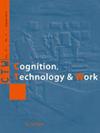探索经认证的手部治疗师在工作场所伤害预防、治疗、康复和与职业安全专业人员合作中的作用。
IF 3.4
3区 工程技术
Q2 ENGINEERING, INDUSTRIAL
引用次数: 0
摘要
背景认证手部治疗是职业/物理治疗的一个子集,对普通个体来说是相对未知的。注册手部治疗师(CHTs)帮助上肢受伤的人,无论是工作场所受伤的人,遭受创伤性伤害的人,还是从大手术中恢复的人,使他们能够独立并重新进行日常生活活动。目的本研究旨在了解持证手治疗师在上肢损伤患者康复中的作用,评估他们在工伤预防中的参与情况,研究在康复过程中与谁进行了互动,并深入了解如何改善持证手治疗师与职业安全专业人员之间的关系。方法采用结构化访谈法对8名已获得认证或正在获得认证的职业治疗师进行访谈。访谈被记录、转录和分析,以确定与研究目标相关的主题。结果内容分析确定了工作角色、与职业安全专业人员的互动、患者教育在预防和康复中的重要性以及有效治疗工伤的障碍等方面的趋势。结论:冠心病患者对其职业有相似的看法。在进行的八次访谈中,CHTs揭示了共同的主题。具体来说,许多中科医生认为,就提高专业水平和康复过程而言,教育是该专业的重要组成部分。此外,患者的依从性和现行的工人赔偿制度被视为康复患者的挑战。本文章由计算机程序翻译,如有差异,请以英文原文为准。
Exploring certified hand therapists' roles in workplace injury prevention, treatment, rehabilitation and collaboration with occupational safety professionals.
BACKGROUND
Certified Hand Therapy is a subset of occupational/physical therapy that is relatively unknown to the common individual. Certified Hand Therapists (CHTs) help those with upper extremity injuries, whether it be those with workplace injuries, those who suffered a traumatic injury or those recovering from major surgery to reach the point where they are able to be independent and back to doing daily life activities.
OBJECTIVE
This study aimed to discern the roles that Certified Hand Therapists have in rehabilitating individuals with upper extremity injuries, to assess their participation in work-related injury prevention, to examine with whom CHTs interact with during the rehabilitation process, and to gain insight into how the relationships between CHTs and occupational safety professionals can be improved.
METHODS
Structured interviews were conducted with eight occupational therapists who are Certified Hand Therapists or are in the process of being certified. Interviews were recorded, transcribed and analyzed to determine themes relative to the study objectives.
RESULTS
Content analyses determined trends in job roles, interactions with occupational safety professionals, the importance of patient education in prevention and rehabilitation and barriers to effective treatment of work-related injuries.
CONCLUSION
CHTs shared similar thoughts regarding their profession. CHTs revealed common themes in the eight interviews conducted. Specifically, many CHTs believe education is a vital part of the profession in terms of improving the profession and in the rehabilitation process. In addition, patient compliance and the current workers' compensation system were seen as challenges when rehabilitating patients.
求助全文
通过发布文献求助,成功后即可免费获取论文全文。
去求助
来源期刊

Cognition Technology & Work
ENGINEERING, INDUSTRIAL-
CiteScore
6.90
自引率
7.70%
发文量
26
审稿时长
>12 weeks
期刊介绍:
Cognition, Technology & Work focuses on the practical issues of human interaction with technology within the context of work and, in particular, how human cognition affects, and is affected by, work and working conditions.
The aim is to publish research that normally resides on the borderline between people, technology, and organisations. Including how people use information technology, how experience and expertise develop through work, and how incidents and accidents are due to the interaction between individual, technical and organisational factors.
The target is thus the study of people at work from a cognitive systems engineering and socio-technical systems perspective.
The most relevant working contexts of interest to CTW are those where the impact of modern technologies on people at work is particularly important for the users involved as well as for the effects on the environment and plants. Modern society has come to depend on the safe and efficient functioning of a multitude of technological systems as diverse as industrial production, transportation, communication, supply of energy, information and materials, health and finance.
 求助内容:
求助内容: 应助结果提醒方式:
应助结果提醒方式:


